Question and Answer: March 2014
If you’d like Neil’s help with a gardening question, send it to Neil here. Without wanting to sound too restrictive, here are a couple of his requests. First, each question must have a photo. And second, please, no plant ID questions, as they normally don’t make for interesting reading for others. Simple as that. Now, here are your questions and his answers for this issue.
Question: My chinquapin oak is being attacked by woodpeckers. Will they do serious damage to the tree? Should I be doing something to stop them? P.T., Burleson.
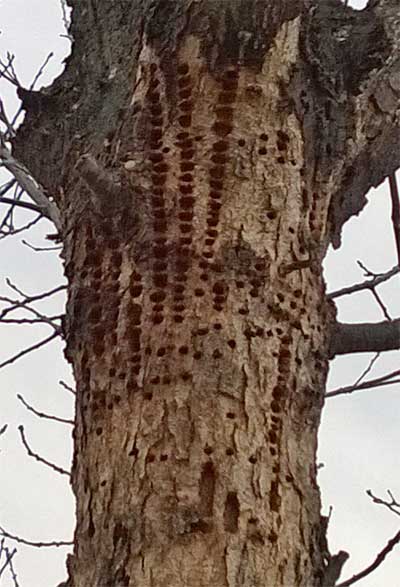
Answer: Sapsuckers and woodpeckers can really riddle a tree’s trunk. They rarely cause any major damage, although this bird is really taking out a lot of frustration on your specific tree. You might buy some Tree Tanglefoot and smear it over the wound area. The bird will feel the stickiness and hopefully move on. The birds are protected species, so don’t do anything to harm them.
Question: The back of my house faces west, but because of the trees, I don’t know whether to use sun or shade plants in the beds. It’s in full shade all morning, dappled shade after lunch, and then, when the sun moves below the trees’ tops, full sun for several hours each day. It’s very sandy soil. L.McM., Springtown.
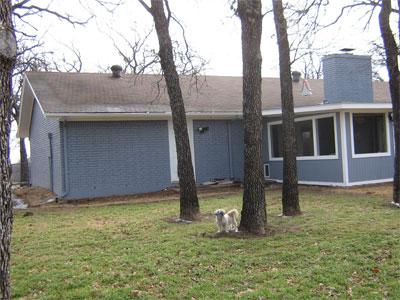
Answer: I would go for sun plants that can tolerate some amount of shade (as opposed to sun shrubs like Texas sage, crape myrtles, junipers and althaeas that must have full sun). The list I would consider would include all of the adapted hollies (there are probably 30 types), plus nandinas, abelias, Encore and other azaleas. For color, I would avoid sun-worshippers like lantana, moss rose, purslane, marigolds, zinnias and many others, opting instead for bronze-leafed wax begonias, maybe pentas, purple fountaingrass, sun-tolerant coleus, and caladiums, among many others. Let your local independent nurseryman advise you.
Question: For the record, should bicolored iris that have been burned by the winter be cut back to get rid of the browned leaves? B.B., Brenham.
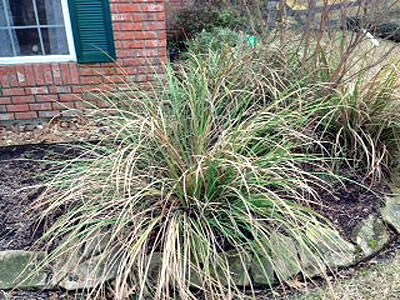
Answer: You can always trim off dead foliage and, in the case of trees and shrubs, dead branches. However, with clumping plants such as yours (also pampasgrass, liriope, etc.), you must be careful not to cut any of the new growth that might show the “scars” of the trim for the rest of this growing season. You’re going to have a difficult time working your way through the plant. Do just a few leaves at a time.
Question: There are several oaks on property we are clearing. After removing cedars and hackberries, we discovered one oak with a large break in a limb. The break appears to be old, and it is not completely through. The limb drops to the ground and has new growth at the end. Should we remove this branch? R.C., no city given.
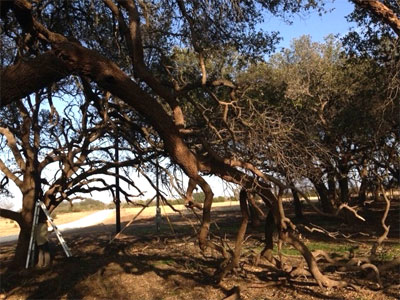
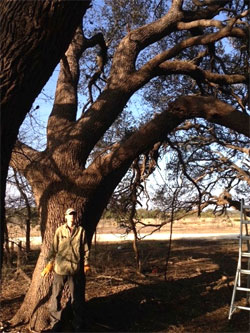 Answer: The fact that it’s an old break and that it is resting against the ground both relieve my worry that it could come crashing down. My advice would be to complete all removal of other dead and mangled branches, also those that are obviously growing off-course. At that point, see what this branch adds to the long-term good looks of the tree, also what the tree would look like if you were to remove it. It’s an interesting novelty, but you may decide that it looks like what it actually is – a broken branch that should have been removed years ago. Totally your call, but if you do decide to remove it, you need to get the job done quickly (and carefully, for your safety). You’re about to go into active oak wilt season when all pruning of oaks should stop until mid-summer. Without knowing where you are, it may be a bit late (South Texas, for example).
Answer: The fact that it’s an old break and that it is resting against the ground both relieve my worry that it could come crashing down. My advice would be to complete all removal of other dead and mangled branches, also those that are obviously growing off-course. At that point, see what this branch adds to the long-term good looks of the tree, also what the tree would look like if you were to remove it. It’s an interesting novelty, but you may decide that it looks like what it actually is – a broken branch that should have been removed years ago. Totally your call, but if you do decide to remove it, you need to get the job done quickly (and carefully, for your safety). You’re about to go into active oak wilt season when all pruning of oaks should stop until mid-summer. Without knowing where you are, it may be a bit late (South Texas, for example).
Question: I’ve had abelias for at least 25 years at several locations, but this year’s cold hurt them more than I’ve ever seen. Should I just leave them alone? Would you anticipate that I’ll need to prune them back by several inches? J.J., Parker County.
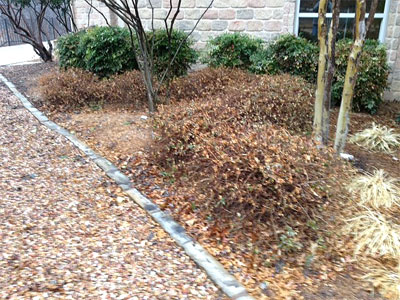
Answer: The answers will soon become obvious as the plants begin their new growth this spring. I’ve seen abelias growing much farther north outside Texas. Probably being encased in ice for several days took a toll on their foliage. My bet is that any pruning that might be needed will be minimal. Sit tight for now.
Question: We had some shrubs planted in the spring to give us some privacy along a wrought iron fence. The problem is where the drainage of the yards goes. Between the drainage and the grasshoppers, the plants didn’t do well, as you can see. Any advice? P., Westlake/Southlake.
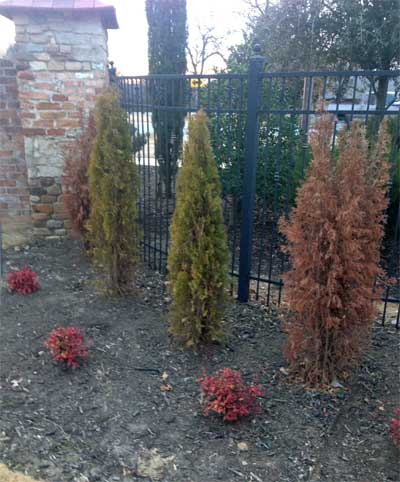
Answer: Honestly, I don’t believe that either drainage issues or grasshoppers caused these arborvitae problems. If the plants got too dry, even just one time, this could be the result. After I read your question, I actually expected to see a boggy, low area, but I then opened the photo and found it doesn’t look that way at all. I’ve seen hundreds of these new types of arborvitae crumble in their first summers in Texas. They just are not well suited here. I had one of my own, and it was gone by mid-summer in spite of my care. They are suited to more moderate climates such as the Pacific Northwest. If this were my landscape, I would be planting Oakland or willowleaf hollies there on 4-foot centers. I might put a Carolina jessamine or other small-growing vine across the wrought iron for some color and variety in growth form, and I would use a groundcover like purple wintercreeper to cover the soil.
Question: This abelia grows way too tall. I keep pruning it, and it keeps growing taller than the sprinkler head. It almost takes a machete to cut it back. I cut it last spring, and because of the water restrictions, this is all it regrew. What can I plant there that will stay shorter and need less maintenance. There are Indian hawthorns beside it and dwarf nandinas in front of it. C.D., Heath.
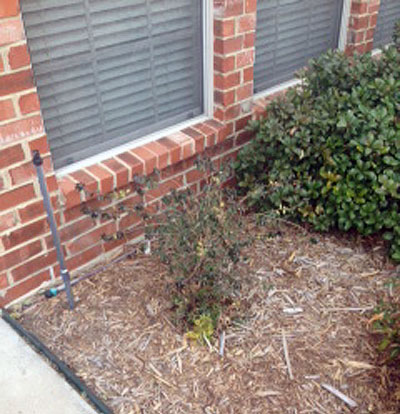
Answer: Poor plant! Move it out into the open somewhere where it can thrive and grow to its full mature size of 6 or 8 feet tall and wide. Abelias are fabulous shrubs. There are dwarf forms of abelias that might be of interest to you. However, my recommendation, best I can tell from this one photo, would be dwarf yaupon holly. It would stay short, and it would offer nice variation in texture from the other two types of plants. You would probably need three dwarf yaupon plants. Tam juniper might be another alternative, but it would eventually grow out onto the lawn and the walk. (I did see your spiraea photos, but since the plants are bare due to winter, it’s difficult to help with what might have killed some of the branches. Most likely drought. I’ve not seen any insect or disease problem bother spiraeas.)
Question: Instead of producing acorns, our live oak produces these growths. The foliage is much thinner than it used to be. What causes this, and what can I do to stop it? B.A., McKinney.
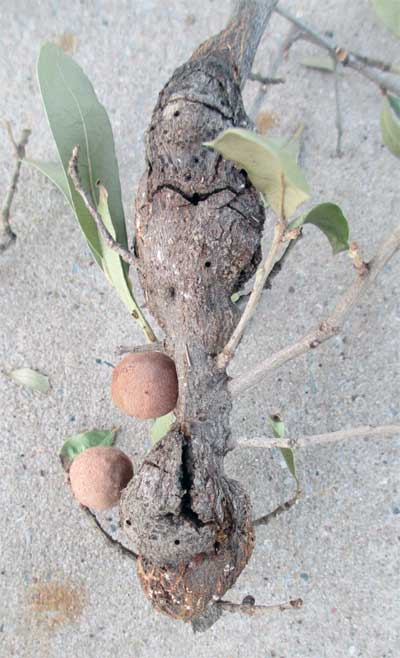
Answer: These are two of the scores of types of galls that attack oak trees in Texas. Although the galls do cosmetic harm to the tree, live oaks almost always co-exist with them quite well. The galls will be worse some years than others. The round ones are woody oak galls, and they’re quite common. A wasp-like insect stings the plant’s twigs, and these are the woody growths that the plant makes around the developing larvae in response to the stings. There is no chemical spray that will prevent or control these, and since they are rarely very harmful, you’re probably fine just leaving them alone. The thinning of foliage could certainly be due to a need for more nitrogen and water during the growing season. Hope that helps. (The weed grass photo you sent in the other post appears to show rescuegrass. Scalp your lawn now, and most of it will be gone. Apply Halts or Dimension pre-emergent weedkiller granules in early September to prevent germination of next year’s crop.)

